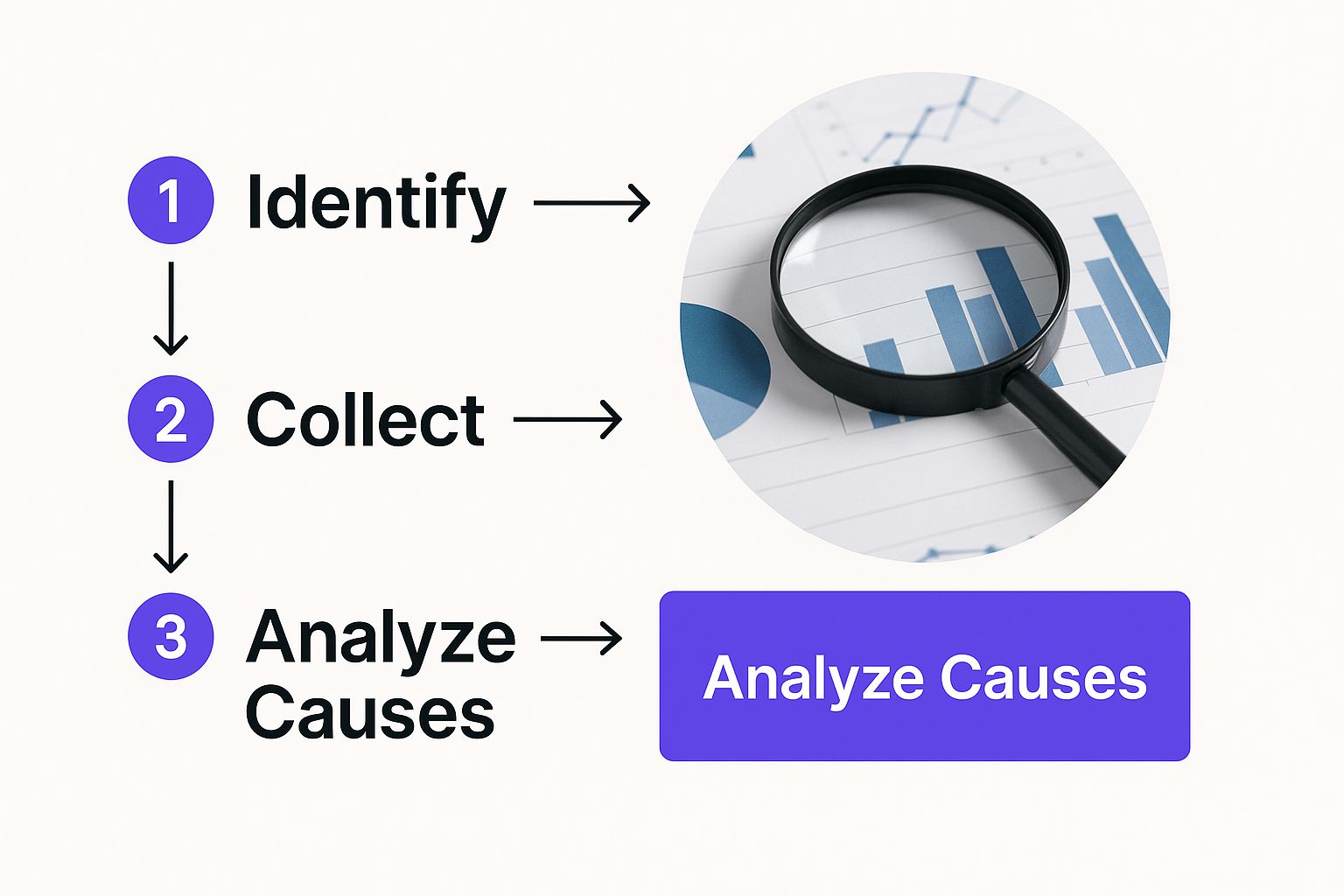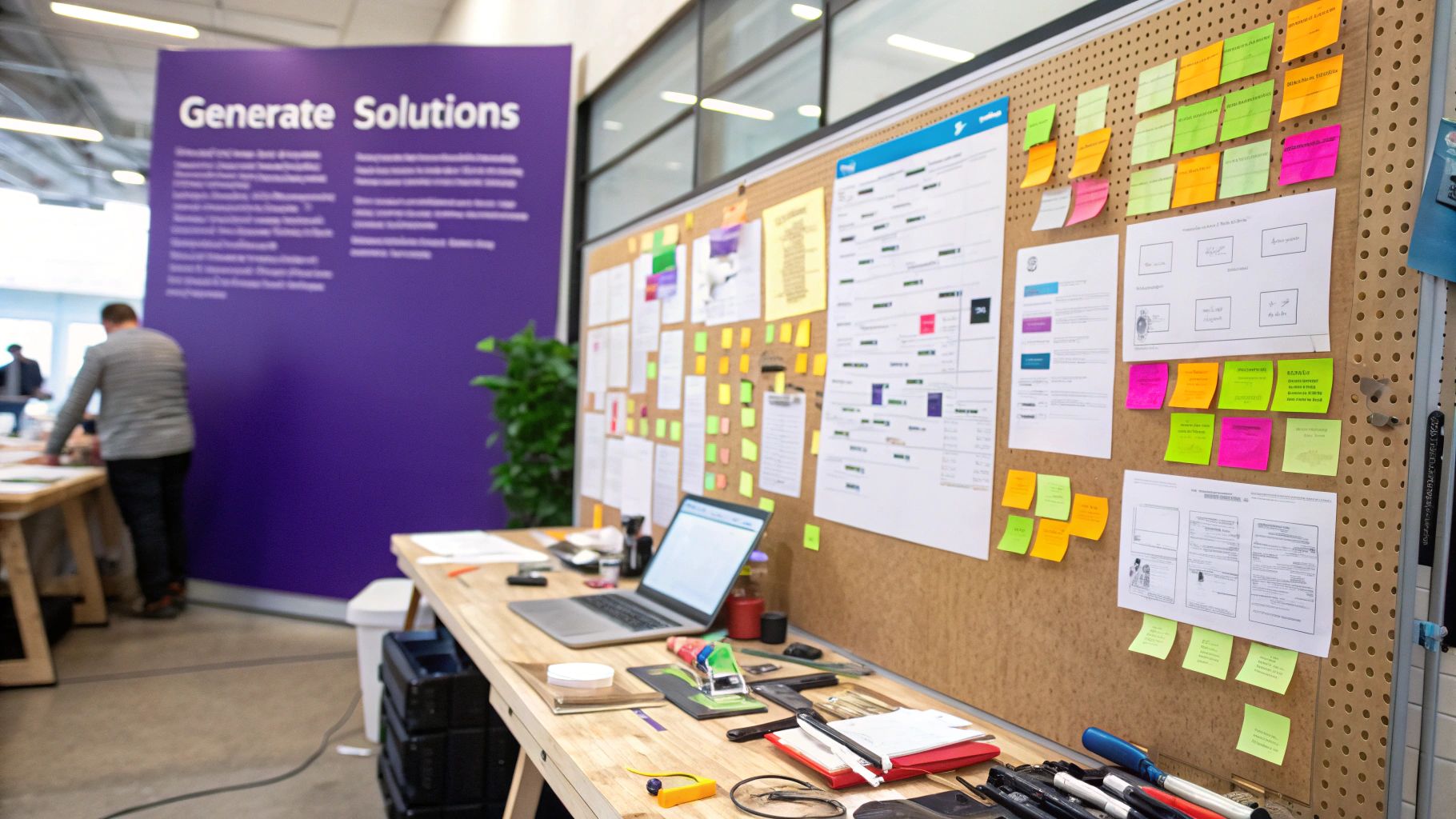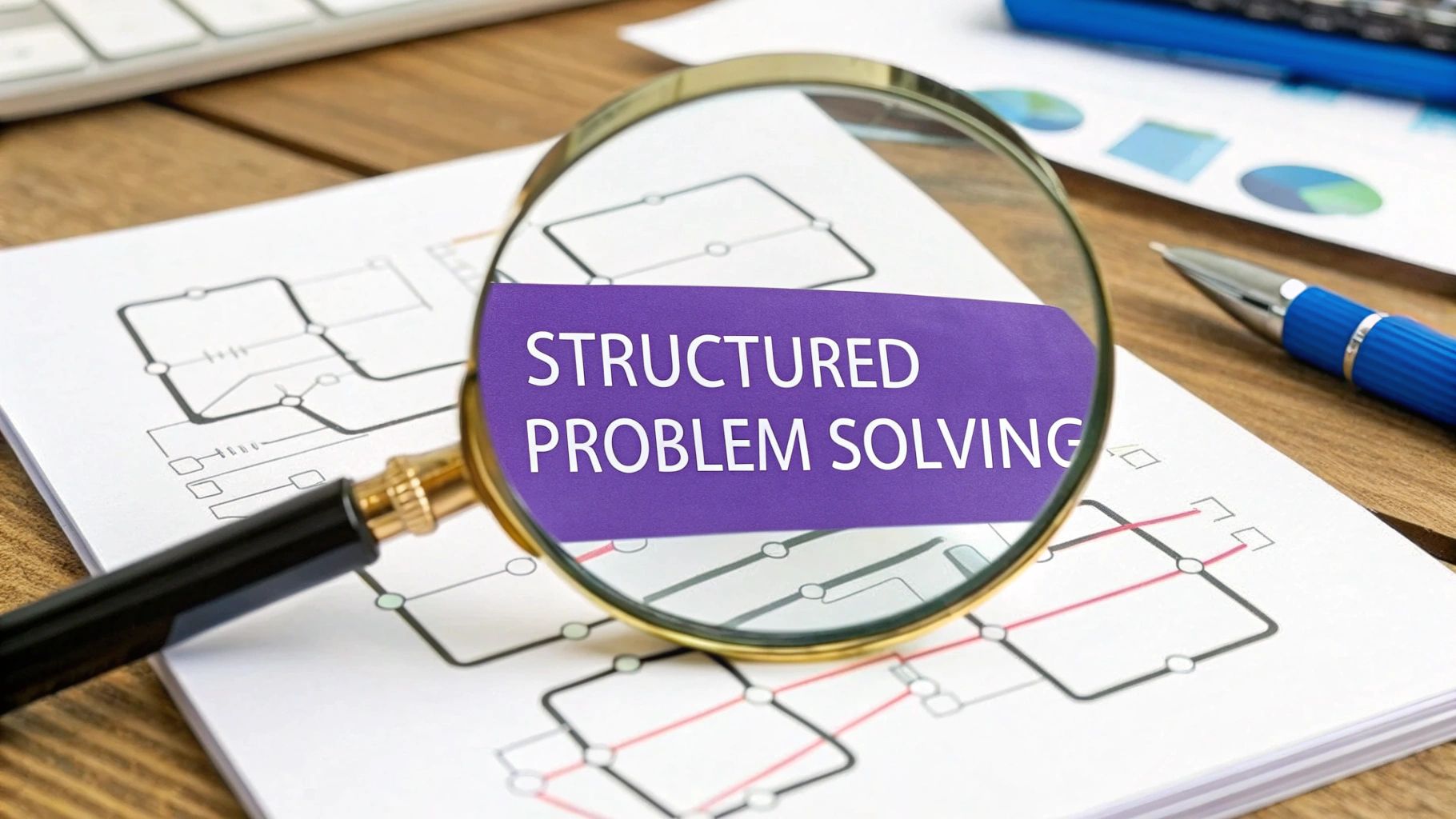A structured problem-solving approach is really just a clear, step-by-step way to get from a state of confusion to a solution that actually works. Think of it as a reliable roadmap that keeps your team focused on data and root causes, not just symptoms and the frantic, day-to-day 'firefighting' that burns everyone out.
This proactive method creates clarity, makes collaboration easier, and helps ensure the solutions you build are made to last.
Moving From Firefighting to Effective Solutions
Picture a detective showing up at a crime scene. They don't just arrest the first person they see. Instead, they secure the area, gather evidence, and carefully analyze clues before even thinking about a suspect. A structured problem-solving approach does the exact same thing for your business. It replaces chaotic, reactive decisions with a systematic process for finding the real issue and creating a solution that sticks.
This disciplined method is the polar opposite of 'firefighting'—that familiar cycle of jumping from one crisis to the next without ever fixing what caused it in the first place. When teams are stuck in firefighting mode, they're usually running on gut feelings, biased assumptions, or just not enough information. The result is always the same: quick fixes that fall apart, leading to the same problems popping up again and again, draining time and resources.
The Benefits of a Methodical Approach
A structured approach makes your team slow down, ask better questions, and gather real data before jumping into action. This deliberate process helps you:
- Avoid Biased Decisions: It takes emotion and personal opinions out of the picture, grounding the solution in facts and evidence.
- Identify Root Causes: Instead of just patching up symptoms, you use specific tools and techniques to dig deeper and find the source of the problem.
- Foster True Collaboration: It gives everyone a shared language and a clear process, so the whole team can contribute effectively toward a common goal.
Adopting this mindset is about building lasting capabilities, not just applying temporary patches. It empowers teams to solve complex challenges by ensuring the solutions they implement are truly the right ones, leading to more sustainable outcomes. To dig deeper, you can learn more about how to master structured problem solving and boost your team's performance.
Let's break down the core advantages of this approach.
Key Benefits of Structured Problem Solving
| Benefit | Description |
|---|---|
| Increased Clarity | Provides a clear roadmap, reducing ambiguity and confusion from the start. |
| Data-Driven Decisions | Moves teams away from guesswork and toward solutions based on evidence. |
| Efficient Resource Use | Prevents wasting time and money on "quick fixes" that don't solve the core issue. |
| Improved Team Alignment | Creates a unified process and language that gets everyone on the same page. |
| Sustainable Solutions | Focuses on fixing the root cause, which prevents the same problem from recurring. |
| Reduced Risk | Allows for testing and validation before a full-scale, expensive rollout. |
Ultimately, a structured framework gives teams the confidence that they're not just busy, but are actually solving the right problems in the right way.
Reducing Failure Through Experimentation
Many modern problem-solving methods now mix traditional frameworks with iterative experimentation. This is especially powerful when you're up against complex business challenges with a lot of moving parts. Industry leaders have found that testing solutions on a small scale before a full rollout is a huge factor in their success.
In fact, this practice of iterative testing has been shown to reduce failure risks by approximately 35-40%. It’s a smart way to make sure you're investing resources in solutions that have already proven they can work. By embracing a structured, evidence-based process, your organization can confidently move from confusion to clarity.
Exploring Popular Problem Solving Models

When it comes to tackling tough challenges, there's no single magic bullet. Every problem is different. That’s why a smart structured problem solving approach isn't about finding one perfect formula, but about building a toolkit of reliable models.
Think of it this way: a carpenter doesn't use a hammer for every job. They choose the right tool for the task at hand. Similarly, these frameworks give your team the specific steps needed to move from confusion to clarity. Two of the most trusted and effective models are the PDCA cycle and the Double Diamond model.
The PDCA Cycle for Continuous Improvement
The Plan-Do-Check-Act (PDCA) cycle is a classic for a reason. It's the engine of continuous improvement, perfect for refining processes you already have in place. Think of it as a methodical feedback loop for making small, controlled changes and seeing what happens.
It’s the ideal tool for spotting inefficiencies or fixing recurring glitches. A support team, for instance, might use PDCA to lower their average response time. They’d plan a new workflow, do it with a few agents, check the performance data, and then act to roll it out to everyone if it worked.
This cyclical process helps teams learn from both their successes and failures. It's a key component of building a high-performance organization, often sitting at the heart of an Operational Excellence Framework that guides a company’s overall strategy.
The Double Diamond Model for Creative Innovation
On the flip side, what if you're not even sure what the real problem is? That's where the Double Diamond model shines. It was developed by the British Design Council for creative fields where you need to innovate, not just optimize.
The whole idea is to first explore the problem as widely as possible before you even think about solutions. It breaks the process into two distinct phases, or "diamonds."
The first diamond is all about the problem space:
- Discover: Your team goes wide, gathering research and user insights without judgment. No idea is too silly at this stage.
- Define: You then narrow down, analyzing all that information to pinpoint the actual core problem you need to solve.
The second diamond moves into the solution space:
- Develop: Time to go wide again. Here, you brainstorm and prototype a bunch of different solutions to the problem you just defined.
- Deliver: Finally, you narrow back down by testing and refining the best concepts until you have a final, validated solution ready to go.
This approach has become a global standard because it works. It forces teams to resist the natural urge to jump on the first solution they think of. This simple discipline ensures you're solving a real, well-understood need, which is why organizations using it often report a 30-40% improvement in project success and user satisfaction.
While PDCA and the Double Diamond are fantastic starting points, they're just two of many tools. To round out your team's skills, you might want to explore our guide on 9 powerful problem-solving techniques for 2025.
The Four Steps at the Heart of Every Framework
While there are plenty of specific models out there—like PDCA or the Double Diamond—they all really boil down to the same core ideas. Think of it less like a rigid script and more like a shared DNA. Beneath all the fancy diagrams and acronyms, you'll find a universal, four-step foundation that is the engine of any good structured problem solving approach.
Once you get the hang of this basic blueprint, you can adapt to pretty much any situation, even if you don't have a formal framework memorized. It’s a bit like learning the fundamentals of cooking. After you master heat control and how to season properly, you can whip up countless dishes without being glued to a recipe. These four steps are your kitchen fundamentals for tackling problems.
Step 1: Define the Problem
This first step sounds obvious, but it’s where most teams stumble. You have to clearly define what you're actually trying to solve. Too often, people rush past this part and end up putting a bandage on a symptom instead of treating the real illness. A crystal-clear problem statement is your team’s North Star, making sure everyone is rowing in the same direction.
A fantastic tool for this is the "5 Whys." It's a simple but surprisingly effective technique where you just keep asking "Why?" to dig deeper.
- The initial issue: A customer is unhappy.
- Why? Their delivery was late.
- Why? The warehouse took too long to fulfill the order.
- Why? A key item was out of stock.
- Why? Our inventory forecast was way off.
- Why? The forecasting software doesn't account for seasonal demand spikes.
And just like that, a vague complaint about customer service becomes a very specific, fixable issue with your forecasting software. You've successfully moved from the symptom to the cause. If you want to dig deeper into this crucial first phase, you can check out these essential https://www.remotesparks.com/problem-solving-process-steps/ that lay the groundwork for any project.
Step 2: Find the Root Cause
Okay, you've got a well-defined problem. Now what? The next step is to map out every single thing that could be causing it. This is where you zoom out and play detective, investigating all the potential culprits.
A classic tool for this is the Fishbone Diagram (sometimes called an Ishikawa Diagram). It helps you brainstorm potential causes across different categories, like People, Processes, or Technology. This prevents you from getting tunnel vision and latching onto the most obvious cause. Instead, you create a complete map of the problem landscape.
This infographic shows just how central that focused analysis is to a structured approach.

By taking the time to do this, you make sure you’re aiming your resources at the true source of the trouble, not just cleaning up its messes.
Step 3: Develop and Select Solutions
With the root cause in your sights, it's time to get creative and brainstorm solutions. At this stage, the goal is quantity over quality. Just get all the ideas out on the table, no matter how wild they seem. Encourage your team to think freely without any judgment.
Once you have a good, long list, you can switch gears and start evaluating. A simple decision matrix works wonders here. Score each idea against a few key criteria:
- Impact: How well will this actually solve the problem?
- Effort: How much time and how many people will this take?
- Cost: What’s the price tag?
This simple exercise helps you move from a free-for-all brainstorm to a smart, data-backed decision.
Step 4: Implement and Measure
Finally, it’s go-time. This is where you put your chosen solution into action. But this step is about more than just doing the work; it requires a solid plan and a way to know if you've succeeded.
Before you start, you need to define what "success" actually looks like. Be specific. For our inventory example, a success metric might be: "Reduce inventory forecast errors by 15% within the next quarter."
A solution without measurement is just a guess. By defining success metrics upfront, you create a feedback loop that tells you whether your fix is actually working or if you need to adjust your approach.
This last step closes the loop and turns problem-solving from a one-off event into a cycle of continuous improvement. This kind of structured thinking is invaluable for tackling all sorts of business challenges, like figuring out how to go about improving user engagement on your website. By following these four core steps, any team can bring order to chaos and build solutions that last.
Solving Problems with Values and Ethics

The most effective solution isn't always the cheapest or fastest. In my experience, the best choice is the one that lines up with your organization's core values and ethical standards. A modern structured problem solving approach has to look past pure performance and think about the real human impact of a decision.
This is the heart of value-based problem solving, a method that puts fairness, responsibility, and stakeholder trust front and center. By weaving ethics directly into how you solve problems, you stop asking "Does it work?" and start asking "Is it right?" That simple shift is everything if you want to build long-term success with solutions that are not just effective, but also honorable.
Justifying Decisions with the 4W Model
Let's walk through a common example. Imagine a company building a new AI hiring tool. A purely technical mindset would focus on one thing: screening resumes as fast as possible. But if you only chase speed, you can easily build a tool that accidentally magnifies old biases and screens out great candidates from different backgrounds.
A value-based framework makes the team face these tough ethical questions from the start. A fantastic tool for this is the 4W framework, which forces you to justify choices by asking a few critical questions:
- What? What exactly is the solution we're proposing?
- What is the basis? Which company values and principles support this solution?
- Ways how? How are we going to implement this solution responsibly?
- Why? Why is this the most ethical and fair option we have?
Suddenly, the AI development team has to prove their tool is grounded in fairness and equal opportunity, not just raw efficiency.
This isn't just theory. A 2020 study on the 4W framework found that requiring teams to spell out and defend the values behind their decisions created a much stronger sense of responsibility. In fact, solutions developed this way saw stakeholder buy-in improve by up to 25%. You can discover more insights about these value-based findings and see how they encourage responsible innovation.
By putting values at the center of the process, you create solutions that people can trust. This ethical filter helps ensure that what you build is not only technically sound but also socially responsible and built to last.
This thinking changes problem-solving from a dry, technical task into a thoughtful, human-centered one. It’s a core part of creative problem solving, where the goal is to come up with answers that are both clever and conscientious.
How to Build a Problem Solving Culture in Your Team
Getting your team to adopt a new system isn't as simple as sending out a memo. If you want to make structured problem solving a core part of how your team operates, you need a real-world plan. The goal is to make systematic thinking feel like second nature, turning chaotic firefighting into a calm, collective effort.
This shift starts with getting genuine buy-in from everyone, from leadership down to the front lines. Leaders need to grasp the long-term payoff, while your team needs to feel empowered by the change, not burdened by another process. A true culture shift happens when everyone understands the why behind it and sees how it makes their work less frustrating and more meaningful.
Secure Buy-In and Demonstrate Value
The first hurdle you'll likely face is skepticism. Your team might worry that a formal process will just slow them down, and leadership might question if the effort is worth it. The best way to win them over is to show, not just tell. Frame the new approach as a tool to cut down on frustration and rework, not as another layer of red tape.
Start small with a pilot project—something highly visible. Pick a nagging, well-known problem that everyone’s tired of dealing with. Guide the team through a simple framework to arrive at a clear, data-backed solution. When you can point to a tangible win, like a 10% reduction in customer complaints in the first month, you create powerful proof that the system works.
For teams aiming for operational excellence, specialized tools can be a huge help. A great example is mastering marketing workflow management software, which helps keep complex projects on track.
Run Engaging and Practical Training
Once you’ve built some momentum, it's time for training. Forget dry, theoretical lectures. Your sessions need to be interactive and hands-on. Use real problems your team is facing right now as your training material. This makes the concepts feel immediately useful and relevant.
A fantastic way to practice these skills is to weave problem-solving exercises into your regular meetings. This has the added benefit of reinforcing collaboration and connection, which is central to any effective remote team building strategy.
The key to successful training is making it feel less like a lesson and more like a collaborative workshop. When people use the tools to solve their own real-world issues, the value of a structured problem solving approach becomes undeniable. The process clicks, and adoption follows.
The Power of Structure in Team Dynamics
Let's be honest: the difference between a team that tackles problems with a plan versus one that just wings it is night and day. Ad-hoc, reactive teams often feel like they’re stuck in a hamster wheel of stress and recurring issues. In contrast, teams with a structured approach build momentum and find solutions that actually stick.
Take a look at how these two methods stack up.
Structured vs Ad-Hoc Problem Solving in Teams
| Metric | Ad-Hoc (Reactive) Approach | Structured Approach |
|---|---|---|
| Decision-Making | Based on gut feelings, opinions, or the loudest voice in the room. | Based on data, evidence, and a clear definition of the problem. |
| Team Focus | Jumps from one crisis to another, addressing only symptoms. | Focused on identifying and solving the root cause for lasting impact. |
| Outcomes | Quick fixes that often fail, leading to the same problem reappearing. | Sustainable solutions that prevent recurrence and improve processes. |
| Team Morale | High stress, burnout, and a sense of "running in place." | Empowerment, shared ownership, and a feeling of collective progress. |
| Accountability | Blame is common when solutions fail; ownership is unclear. | Clear ownership and shared responsibility for implementing and measuring results. |
By championing this cultural shift, you’re not just implementing a process. You’re guiding your team to become more resilient, methodical, and consistently successful problem-solvers.
Frequently Asked Questions
As you start weaving a structured problem-solving approach into your team's workflow, you're bound to have some questions. It’s a real shift in mindset, moving away from putting out fires and toward digging for the root cause. Let's tackle some of the most common hurdles people face.
Getting a handle on these common sticking points upfront can make the transition a lot smoother and help you build a truly resilient problem-solving culture.
What Is the Biggest Mistake People Make?
The most common trap, by a long shot, is jumping to a solution before anyone truly understands the problem. It's human nature—we see something broken, and our immediate instinct is to fix it. But rushing in like that often means you're just patching up a symptom, not curing the underlying disease.
Think about it this way: a team might sink weeks into redesigning a clunky webpage (the "solution"), when the real issue is that their marketing is sending the wrong type of customer there in the first place. A structured approach forces you to hit pause, look at the data, and define the actual problem first. It feels slower initially, but it saves a massive amount of wasted time and effort down the road.
Can This Work in a Fast-Paced Agile Environment?
Absolutely. In fact, structured problem-solving and agile methodologies are a perfect match. The structure adds a layer of methodical rigor to agile's inherent speed, making your team not just fast, but smart. You can easily bake frameworks like the PDCA (Plan-Do-Check-Act) cycle right into your sprints.
Here’s a practical example of how it could work:
- Sprint 1 (Plan): The entire sprint is focused on research and discovery to nail down a crystal-clear definition of the user's problem.
- Sprint 2 (Do): Now you develop a feature or a minimum viable product specifically aimed at that well-defined problem.
- Sprint 3 (Check/Act): You release the feature to a test group, analyze the results, and decide what to do next based on real data.
This creates a powerful feedback loop where you're moving quickly, but you're also learning and validating with every step you take.
By blending these methods, you ensure your team's velocity is always pointed in the right direction. It turns raw speed into focused, intelligent action.
Which Problem-Solving Framework Is Best for a Beginner?
If your team is just dipping its toes into this, the ‘5 Whys’ technique is the perfect place to start. Its beauty is in its simplicity. It’s a fantastic exercise that trains your brain to push past the obvious, surface-level issue and dig deeper by repeatedly asking "Why?"
Once everyone gets comfortable with that line of thinking, graduating to the PDCA cycle is a natural next step. It gives you a complete, yet simple, framework for not just finding problems but testing solutions and making sure they stick. Mastering these two tools will give you a solid foundation for handling almost any challenge that comes your way.
Ready to transform your team's brainstorming sessions from chaotic to clear? Bulby provides the guided structure you need to generate brilliant ideas and solve complex problems together, no matter where your team is located. Start your journey with Bulby today.

